#pyrenees witches
Text
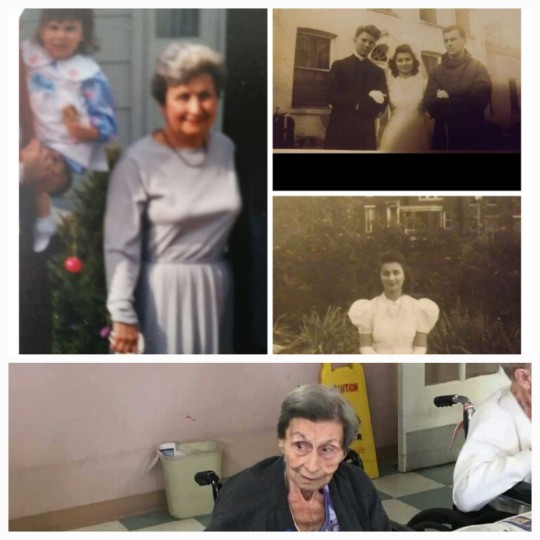
The time of death and ancestral reverence is here. Even though the time of honoring your ancestors is all year round, the fall and winter seasons are the time of death, and as the earths foliage dies and transforms we can see the change more and more each day.
The changes to the earth at this time of year are just like like the changes to the human body as death prepares you for your long journey.
Death and the dead are topics I have always been fascinated with. As a medium and trance channeler, I have always had a close connection to the dead and my ancestors. When my Gigi passed away a few years ago, I felt even closer to the spirit world than ever.
The pictures above are of my Grandmother, it shows the stages of her life until the end. How the slow but inevitable decline changed her form, demeanor, and personality.
My grandmother was a strong loving and caring Neapolitan American Woman, and she is the one who taught me how to love.
Working with the Ancestors is a huge part of my practice and life. If you are new to working with ancestors or you would like to get and idea on how an Italian American Folk Witch honors and works with her ancestors then join me for my new class Saturday October 21 at 7pm.
# samhain # halloween # ancestralveneration # ancestralwisdom # ancestralmagic # folkmagic # mabon # autumnequinox # witchcraft # ancientmedicine # ancestors # ancestralhealing # witchesofinstagram # halloweenmagic # streghe # stregheitaliane # stregoneria # stregoneriaitaliana # janare # janara # majare # majara
#melungeon#halloween#samhain#ancestors#ancestral#spirits#ancestral healing#italian folk medicine#italian#italian folk magic#folklore#pyrenees witches#french folk magic#folk magic#irish#irish witch#italian witchcraft#irish witchcraft#halloweenmagic#streghe#strega#stregoneria#stregheitaliane#Janare#janara#majare#majara#witchcraft#witchblr#autumn equinox
8 notes
·
View notes
Text
A brief introduction to Aragonese Witchcraft
greetings to all! First of all i would like to point out that i don`t speak english so maybe my writing has some strange issues, also i i’m new in tumblr so i don`t how to make beautiful posts. Have patience with me please. Anyway.
Basque witchcraft trials and galician folklore are very well known, but its remarkable that the spaniard witch hunt begun in the northeast area (due to the conecction to France, where the Inquisition was founded). Catalonia and Aragon were the regions in which more witch trials took place, and they share the very rich and old folklore of the Pyrenees.
I would like to make a simple introduction into aragonese witchcraft, but before it i think that i should do a tiny presentation of Aragon.

Aragon is a region located in the northeast of the Iberian peninsule, bordering with France and other iberian regions like Catalonia, Navarre and Valencia. This is the land of the famous painter Francisco de Goya, and of other personalities like Catherine of Aragon (the first wife of Henry VIII), Michael Servetus, Baltasar Gracián, Joaquín Costa or Luis Buñuel (filmaker).
During the Middle Ages it was a reign of its own, but because of the marriage of the spanish catholic monarchs (Queen Isabelle I of Castile and King Ferdinand II of Aragon) the Aragonese Crown started to mix more with Castile originating the future concept of Spain. This map is a representation of the Crown of Aragon during 1492:
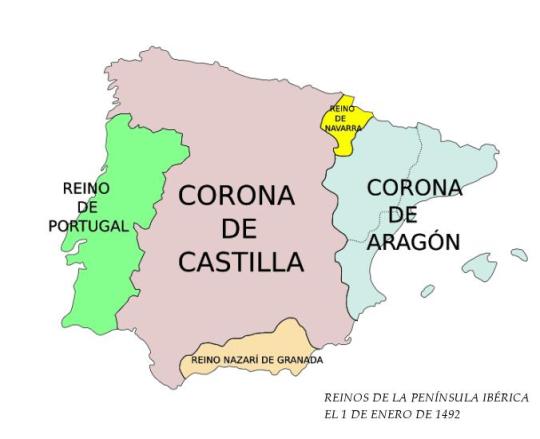
The Witch Hunt started in the peninsule in 1424 due to a pyrenean law that punished “those who go with witches” with death penaltie. In all the Pyrenean area the rumors about a devilish group of people that consorted with Satan weren’t new. The bloody prosecution of cathars influenciated the Crown of Aragon, bringing here not only the ideas about heretics and devil whorshippers but a bad fame to the french foreigns and a growing sensation of insecurity too.
In 1461 on Villanua (Bellanuga in aragonese) a woman named Guirandana of Lay was accused of being a sorceress, and after being carried to Jaca she was found guilty and burnt at the stake. Studies tell that she was probably of Béarnaise origin, and that she worked as a healer before her arrest. In her confessions Guirandana explained that she was the "cap e bordon" (leader) of a local group of poisoners (ponzoñer@s in aragonese), they would met on each other houses to concoct toxic potions and powders and teach the younger members about their making. Later, allegedly, they would poison townfolk because the Devil have told them to do so. Guirandana gave a recipe of a powder that she throwed to the ground in which her victims were stepping to cause the illnes, it was a grinded mix of toads and snakes' bones. Obviusly her confessions are very debatable because torment was presumably used.
Altought Guirandana wasn't accused of witchery at all, her trial set precedent to aragonese witch trials. With Guirandana some other people were likely carried to Jaca and burnt, but in the same area (Cenarbe, a dissapeared village very near) and only 37 years after her polemic a new hunting arosed. Three siblings were suspected of being witches, two of them (Maria and Juan) escaped, but one remained and was chased. She was Narbona Dacal, firstly interrogated by local judges (it was the secular judges and not the Inquisition who more witch hunts started on Spain) but afterwards some inquisitors that had have notice of devil whorshipping and heresy carried she to Zaragoza. In Zaragoza she was tortured and interrogated, her confession depicted a secret cult to the Boc of Biterna (the he-goat of Biterna). Elements like the pact with the Devil and the sacrilege associated with the term "witch" appeared for first time in Aragon with this case. She was burnt at the stake, and on later months other women like Gracia la Valle burnt on september of the same year or Maria (unknown surname, "wife of Garcia Biessa") burnt in 1499 were prosecuted under the witchcraft charge. Since Guirandana in 1461 up to 1645, the aragonese witch trials took place.
Simultaneously as the witch trials were developing, they were arrested also those accused of practising sorcery, divination, necromancy or folk healing. Commonly their penalties were less harsh than those of witches supects, being very rare death and more frequent flagellation, public repentance, humiliation and exile. In a lot of cases witchcraft charge was accompanied by sorcery or poisoning accusations, specially cause "ponzoñería"/"metzinería" (the term in aragonese, and in catalan) was not only considered poison making but specifically witch poison making. The catalan word "metzina" came from the latin and remained the antique ambiguity of poison and medicine.
That made easy the witch accusations to healers and midwifes.

if you like this post perhaps i will write about specific aragonese witch trials or about the figure of the Boc o Biterna. Finally i have to warn you that the vast majority of bibliography is in spanish.
BIBLIOGRAPHY:
· “Abracadabra Omnipotens. Magia urbana en Zaragoza en la Edad Moderna” by María Tausiet Carlés. (this is available in english on the internet).
· “Brujería e Inquisición en Aragón” by Ángel Gari Lacruz.
· “Eros y Tánatos. Brujería, hechicería y superstición en España.” by Juan Blázquez Miguel.
· “Europe’s inner demons” by Norman Cohn.
· “Guirandana de Lay, hechicera, ¿bruja? y ponzoñera de Villanúa (Alto Aragón), según un proceso criminal del año 1461” by José Antonio Fernández Otal.
· “La bruixeria a través de les Ordinacions D’Àneu” by Ángel Gari Lacruz.
· “La brujería en los Pirineos (siglos XIII al XVII). Aproximación a su historia” by Ángel Gari Lacruz.
· “La Mala Semilla. Nuevos casos de brujas” by Carlos Garcés Manau.
· “Las brujas en la historia de España” by Carmelo Lisón Tolosana.
· “Nuevos datos sobre brujería y superstición en Sobrarbe. Siglos XV-XVII” by Manuel López Dueso.
· “Origens i evolució de la cacera de bruixes a Catalunya (segles XV-XVI)” by Pau Castell Granados.
· “Ponzoña en los ojos. Brujería y superstición en Aragón en el siglo XVI” by María Tausiet Carlés.
· “Procesos criminales en el arzobispado de Zaragoza” by M. I. Falcón Pérez y M. A. Motis Dolader.
· “Sanar y dañar en la Baja Edad Media: la medicina, la magia, la brujería y su relación con la sociedad cristiana occidental” by María Pilar García Romano.
· “Vienen de noche. Estudios sobre brujería y la Otredad” by Júlia Carreras Tort. (Co-founder of OccvltaCrafts).
· “Wine vat witches suffocate children. The mythical components of the Iberian Witch” by Pau Castell Granados.
· “Witch or Demon? Fairies, Vampires and Nightmares in Early Modern Spain” by Fabián Alejandro Campagne.
In addition, I have read and reviewed some of the original manuscripts of the trials. Some (very few) are available to read and download online at https://dara.aragon.es/opac/app/results/?p=0&q=brujeria&ob=re:1&vm=nv
#traditional witchcraft#witch hunt#witch history#spain#aragon#folklore#witchcraf#sorcery#poison path#poison making#ponzoñeria#metzineria#pyrenees#zaragoza#catalonia
17 notes
·
View notes
Text

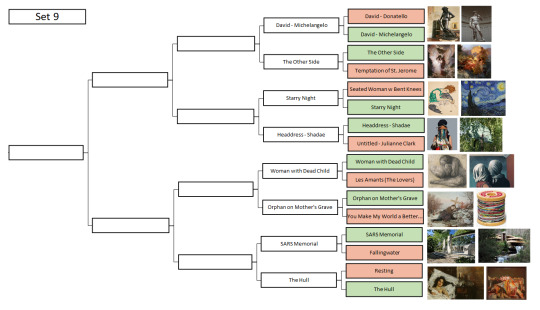

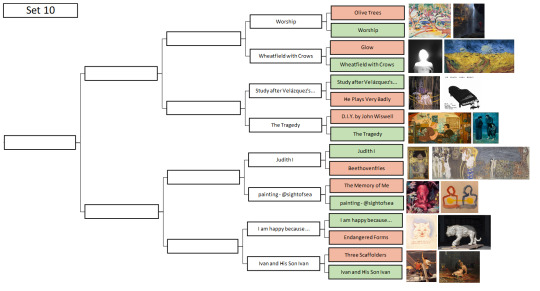









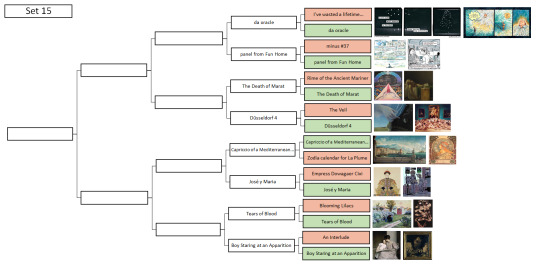
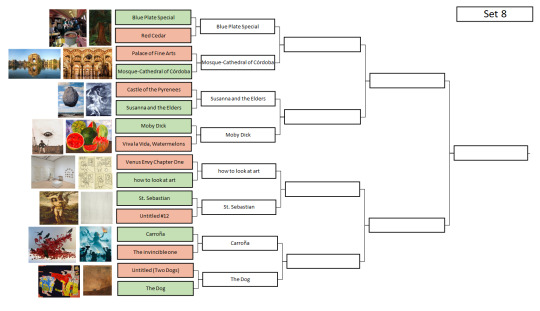

Behold, a bracket!
Text form below the cut because trying to copy all the 256 into the alt text sounded.... horrifying. Warning for 128 matchups, seriously, this list is long, and so I've avoided adding the artists until the polls.
a note: the pinned post has started misbehaving, so only open polls will be directly linked. closed polls instead have the results page linked in the set header, all the polls are linked from there
Set 1
The Lament for Icarus (Miao He) vs The Lament for Icarus (Herbert Draper)
The angel came to me in a fever hallucination, perched upon my bed as I returned from the bathroom. vs Sweet Brown Snail
Figures vs A Philosopher Lecturing on the Orrery
Happy Shoppers vs Hubble Deep Field
Lovers Painting vs Bath Curtain
Dr. Helen Taussig vs Une Martyre
Orangoutang étranglant un sauvage de Bornéo (Orangutan strangling a Borneo savage) vs Can’t Help Myself
Rape vs Technicolor Hiroshima
Set 2
A Walk at Dusk vs Based on “Autoportrait with the Model” by Maria-Rayevska Ivanova
Diary Page vs Les Jours Gigantesques (The Titanic Days)
Dead of Night vs You Won't
Christina's World vs Bobby
Untitled (I’m Turning Into A Specter Before Your Very Eyes And I’m Going To Haunt You) vs Two Sisters (On the Terrace)
Sharecropper vs Lustmord
The Parca and the Angel of Death vs Untitled (Zdzisław Beksiński)
Stress vs The Fallen Angel
Set 3
Device to Root Out Evil vs Travelling Light
Diana vs Fifty Days at Iliam: The Fire that Consumes All before It
The Plains, from Memory vs Exotic Bodies
Doubting Thomas vs Self-Portrait in the Bathroom Mirror
Empty Nest vs Somebody Fell From Aloft
Anguish vs If I Died
Cat in Obsolete Bath vs You're Not Boring Anymore
Salvator Mundi (Savior of the World) vs Untitled (billboard of an empty unmade bed)
Set 4
There Will Be No Miracles Here vs Symphony of the Sixth Blast Furnace
Fox Hunt vs Tarpaulin
Khajuraho Group of Monuments vs Ranakpur Jain Temple
ปราสาทสัจธรรม (The Sanctuary of Truth) vs Grande Panorama de Lisboa
Heroic Head of Pierre de Wissant, One of the Burghers of Calais vs The Weather
The Daughters of Edward Darley Boit vs If this is art
Statue of Vincent and Theo van Gogh vs Jeanne d’Arc écoutant les voix (Joan of Arc listening to the Voices)
Fountain vs Judith Slaying Holofernes
Set 5
Cueva de las Manos (Cave of Hands) vs Cave of El Castillo
Chauvet Cave Bear vs Uffington White Horse
Laocoön and His Sons vs Winged Victory of Samothrace
Crouching Aphrodite vs Statue of Taweret
Guardian Figure vs Kūya-Shonin (Saint Kuya)
Ancient Greek doll vs Arena #7 (Bears)
Enbu (炎舞) (Dancing in the Flames) vs Yearning Shadows
Belfast to Byzantium vs Freedom
Set 6
The Kama Sutra of Vatsyayan vs Portraits
The Blood Mirror vs Nighthawks
Electric Fan (Feel it Motherfuckers): Only Unclaimed Item from the Stephen Earabino Estate vs "Untitled" (Portrait of Ross in L.A.)
Lady Agnew of Lochnaw vs Forgotten Dreams
Saint Bride vs Pixeles (a group of 9 works)
War Pieta vs The Sunset
The Handmaidens of Sivawara Preparing the Sacred Bull at Tanjore for a Festival vs Ajax and Cassandra
Nāve (Death) vs Abstraction
Set 7
Yes vs Meeting on the Turret Stair
Hacked to Death II vs Stańczyk
Closeness Lines Over Time vs Voice of Fire
The Maple Trees at Mama, the Tekona Shrine and Tsugihashi Bridge vs Portrait of Sir Thomas More
Survival Series: In a Dream You Saw a Way vs Takiyasha the Witch and the Skeleton Spectre
Death blowing bubbles vs The Kitchen Table Series
Painting 1946 vs In the Grip of Winter
Untitled (Black and Gray) vs NAMES Project AIDS Memorial Quilt
Set 8
Blue Plate Special vs Red Cedar
Palace of Fine Arts vs Mosque–Cathedral of Córdoba
Le Château des Pyrénées (The Castle of the Pyrenees) vs Susanna and the Elders, Restored - X-Ray
Moby Dick vs Viva la Vida, Watermelons
Venus Envy Chapter One (Of the First Holy Communion Moments Before the End) vs how to look at art
St. Sebastian vs Untitled #12
Carroña vs The invincible one
Untitled (Two Dogs) vs The Dog
SECOND HALF
Set 9
David (Donatello) vs David (Michelangelo)
The Other Side vs The Temptation of St. Jerome
Seated Woman with Bent Knees vs Starry Night
Headdress - Shadae vs Untitled for the Image Flow's Queer Conscience exhibit
Woman with Dead Child (Frau mit totem Kind) vs Les Amants (The Lovers)
Siroče na majčinom grobu (Orphan on Mother's Grave) vs You Make My World a Better Place to Find
Fighting Against SARS Memorial Architectural Scene (弘揚抗疫精神建築景觀) vs Fallingwater
Resting vs The Hull
Set 10
Olive Trees vs Worship
Glow vs Wheatfield with Crows
Study after Velázquez's Portrait of Pope Innocent X vs Untitled (He Plays Very Badly)
D.I.Y. by John Wiswell vs The Tragedy
Judith and the Head of Holofernes vs Beethovenfries (Beethoven Frieze)
The Memory of Me (How Could I Forget) vs oh god i had a really big epiphany about love and personhood but i’m too drunk for words
I am happy because everyone loves me vs 瀕危形態 (Endangered Forms)
Three Scaffolders vs Ivan the Terrible and His Son Ivan
Set 11
San Giorgio Maggiore at Dusk vs Water-Lilies, Reflection of a Weeping Willow
The Grief of the Pasha vs Monolith in Vigeland Sculpture Park
Passion vs Space Diner
Hamlet and Ophelia vs Two Earthlings
Ellen Terry as Lady Macbeth vs Seer Bonnets
Photograph from "SNAP OSAKA" Collection vs Clytemnestra after the Murder
“Untitled” (Perfect Lovers) vs The Lovers (TIE)
Kedai Ubat Jenun vs Orange Store Front
Set 12
The Apotheosis of War vs Portrait of the Dancer Aleksandr Sakharov
Julie Manet vs Mouth
The Icebergs vs Kaleidoscope Cats III
Maman vs Caza Nocturna (Night Hunt)
The Book of Kells Folio 188r: Luke carpet page vs Ardagh Chalice
Yusuf and Zulaikha vs Dome of the Rock mosaics
Rowan Leaves and Hole vs Untitled (prisonhannibal)
Le Désespéré (The Desperate Man) vs The Dedication
Set 13
Deimos vs Dog and Bridge
The Mocking of Christ vs Prudence
The Broken Column vs Siberian Ice Maiden shoulder tattoo
Transi de René de Chalon (Cadaver Tomb of René of Chalon) vs Head of Christ
The Day vs Spirit of Haida Gwaii
Eleanor Boathouse at Park 571 vs Jatiya Sangsad Bhaban জাতীয় সংসদ ভবন (National Parliament House)
Juventud de Baco (Bacchus Youth) vs Barges on the Seine
Oath of the Horattii closeup vs Visit hos Excentrisk Dam (Visit to an eccentric lady)
Set 14
Christ Crucified (With Donor) vs St. Francis
Thunder Raining Poison vs Piazza d'Italia
The Grove vs Among the Waves
Pintura Mural de Alarcón vs Sagrada Família stained-glass windows
Noonday Heat vs La Dame à la licorne (The Lady and The Unicorn)
Matroser i Gröna Lund (Sailors in Gröna Lund) vs Gielda Plakatu
Reply of the Zaporozhian Cossacks vs The Garden of Earthly Delights
Kuoleman puutarha (The Garden of Death) vs Haavoittunut enkeli (The Wounded Angel)
Set 15
i've wasted a lifetime pretending to be me vs da oracle
minus #37 vs Panel from Fun Home
Excerpt from illustrated edition of The Rime of the Ancient Mariner vs La Mort de Marat (The Death of Marat)
The Veil vs Düsseldorf 4 (Museum Kunst Palast)
Capriccio vs Zodiac calendar for La Plume
The official imperial portrait of empress dowager Cixi vs José y Maria
Blooming Lilacs vs Lágrimas De Sangre (Tears of Blood)
An Interlude vs Boy Staring at an Apparition
Set 16
Mermer Waiskeder: Stories of the Moving Tide vs The Gran Hotel Ciudad de México Art Nouveau interior
Unfinished Painting vs To Arms!
Memorial to a Marriage vs The Island
Dropping a Han Dynasty Urn vs A Few Small Nips
Saturn Devouring His Son vs Guernica
Fairy Princesses vs Lamentation over the Dead Christ
Mummy with An Inserted Panel Portrait of a Youth vs Little Girl Looking Downstairs at Christmas Party
Agnus vs The Cup Of His Murders Is Flowing Over And In His Coat Shall Be Many Curses
244 notes
·
View notes
Text

SUMMARY: A photojournalist traveling through the Pyrenees on assignment with a beautiful writer stays overnight at an ancient Spanish castle and hears that the adjoining mountain is occupied by a coven of witches.
Mod Z loves finding a good witch horror in the queue! he’s adding this one to his watchlist with the others
11 notes
·
View notes
Photo

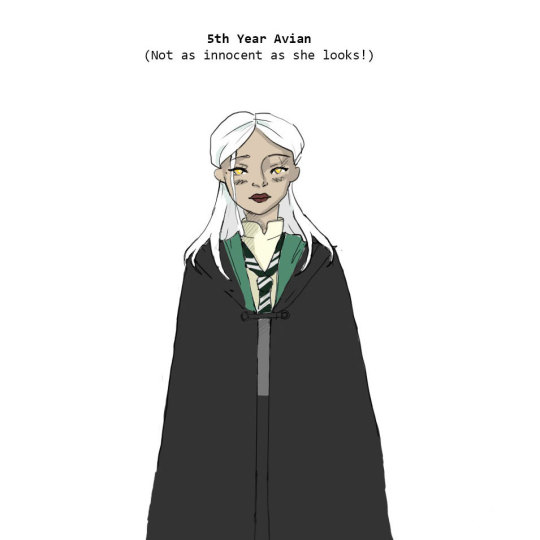
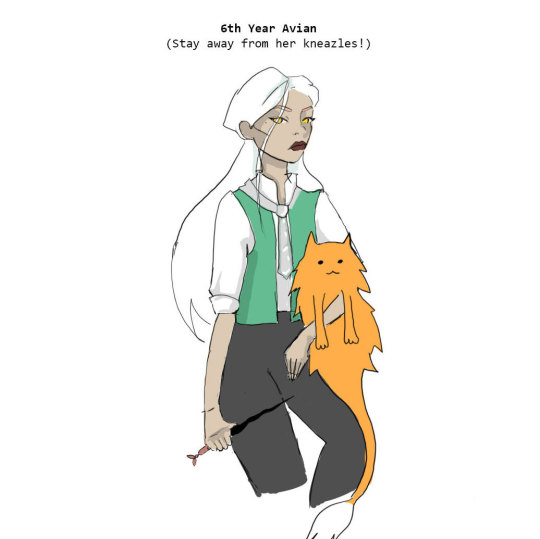

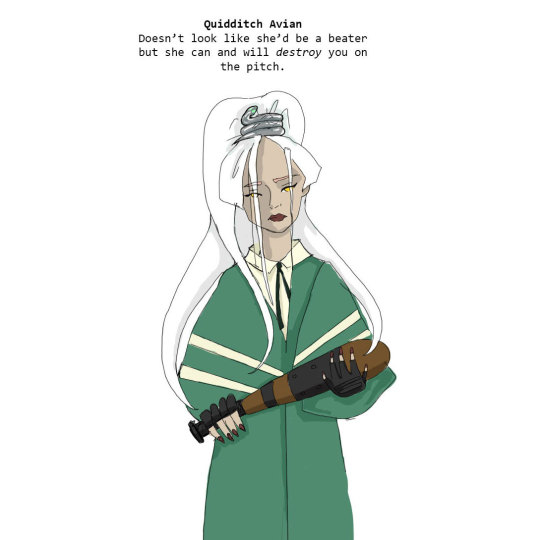
Hogwarts legacy MC bio/headcanons
Avian Grey was born to a Welsh witch in the Pyrenees, France (close to Beauxbatons) she does not have any memory of her parents. She was raised by her mothers sister and research partner “Aunt Efa”.
While researching magical creatures in the Pyrenees, Avians mother had an affair with a man from one of the local villages, all Efa knew about him was that he was from a family that had strong Veela lineage. Avians mother passed away not long after giving birth to her.
Ave and Efa had a very nomadic lifestyle traveling from place to place for purpose of Efa’s research. She gained a lot of experience fighting due to run ins with poachers and other undesirables during their travels. Perhaps it was due to her fate as a wielder of ancient magic that the constant traveling caused her to be late in her admission to Hogwarts, and enter as a fifth year.
Her patronus/potential animagus: A hippogriff. Powerful and dignified, once you earn her trust she will protect you fiercely. If you cross her she will fight you.
Coincidentally her name is French for “bird like”.
I like to think the hippogriffs appearing in her storyline are immensely symbolic having to do with those she trusts. For example during her first trip to Hogsmeade with Sebastian two hippogriffs flew out of the forest, perhaps foreshadowing her relationship with him. Especially as they shared their first kiss after she took him to ride highwing (see fanfic for full story). Additionally the creatures have shown up in situations that involve Natty and Poppy.
Her interests:
-flying and magical beasts, love kneazles and has an entire vivarium just for kneazles. Despite her princess like appearance she likes to play as a beater during quidditch, after all she loves a good fight.
-She gets a high off of fighting. During 7th year her and Sebastian spends alot of their “dates” raiding poacher camps, not only because she wants to save beasts and loves fighting but they both find it insanely attractive watching each other fight (hence why their first duel in Hecat’s class is when they started to like one another) their kink is raiding different poacher camps and then doing it in the empty tent afterwards
Her strengths:
Excellent duelist
Highly ambitious and competitive (can also be a flaw if it gets out of hand)
Fiercly protective of those she loves.
Her flaws:
-Slight temper
-Jealous and sometimes manipulative but she’s better at hiding it than Sebastian. If she sees Sebastian talking to another girl she’ll use subtle tactics to get his attention might take her hair tie out for a second to adjust her hair, he doesn’t get to see fully undone often (until they become official) so it gets his attention, she also might loosen her tie and unbutton the first button of her shirt exposing more of her neck. If she’s feeling extra ambitious she’ll go talk to another student who isn’t Ominis, Poppy or Natty and be mildly flirtatious in asking them for help with something.
-Not always the most trusting..better with beasts than people. However she adores Poppy, Natty and Ominis.
-Easily distracted by anything having to do with Sebastian. Will drop important tasks to spend time with him.
After Hogwarts:
After Hogwarts Her and Seb elope in a quiet ceremony with only their close friends present. They start off as aurors but after Ave nearly gets killed while pregnant with their third child they calm down with the fighting obsession and settle for a more quiet lifestyle. They end up taking over Brood and Peck when Ellie decides to relocate and spend a majority of their lives taking care of magical beasts. They eventually wind up having a total of four daughters and three sons, out of which is a pair of twins (boy and girl like Sebastian and Anne). Because they lost so many of their family members when they were younger, a large family is important to them. Their family goes on to be a very well respected wizarding family throughout the decades. Newt Scarmander visits their shop regularly and they’re really fond of him, usually selling him beast-care tools at a high discount. They also see Poppy regularly as she is the care of magical creatures professor at Hogwarts.
#hogwarts legacy#hogwarts school of witchcraft and wizardry#sebastian sallow x mc#hogwarts legacy mc#myoc#hogwarts legacy oc#hogwarts legacy fanart#slytherin#hogwarts legacy headcanons
20 notes
·
View notes
Text
MCD Sona :]
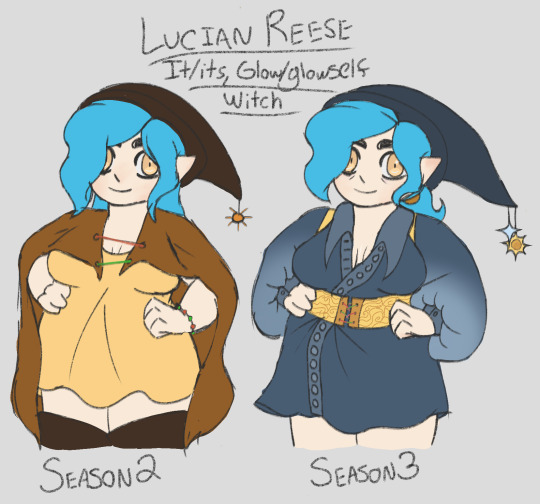
Lucian Reese [last name unknown] | It/its, glow/glowself | Witch.
It lived in New Meteli and when the MCD S2 gang showed in said village, it impulsively decided to tag along on their journey + then even more impulsively decided to join them to the Phoenix Alliance Island. And the island has been its place of residence since.
It’s a witch of average witchcraft abilities and has a tabby cat familiar named Smudge.
It also has two non-familiar pets a gray cat (Russian blue) cat named Kitty and (in season 3) a Great Pyrenees puppy named Sherbet.
It’s a romance author :]. It finished writing its first novel between season two and three.
Also, don’t let that friendly smile and pose fool you, its an 100% introvert and will gladly spend hours upon hours locked inside of its house, doing nothing but writing books.
#Aphblr#MCD#Lucian Reese [MCD Sona]#This was gonna be a fully MS Paint piece but MS Paint was MS Paint now y’all get the Procreate version
3 notes
·
View notes
Text
'A Short Disquisition Concerning Toad-lore'
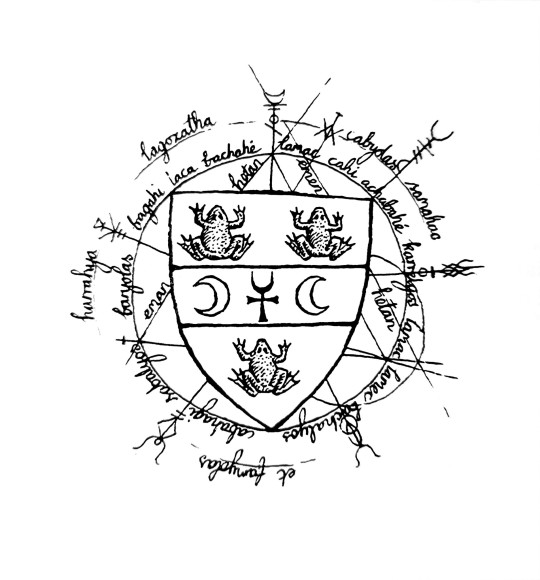
"That remarkable native amphibian, the toad or paddock (Bufo bufo), has a longstanding and celebrated association with witchcraft in the British Isles and Europe, especially as a familiar-spirit. The reasons for the importance of the toad in mediaeval witchlore must ultimately be sought in esoteric folk-symbolism, mythopoetics and the psychopharmacology of rural sorcerers and hexe-wives.
The totemic significance of the toad in witchcraft is primarily due to it's intimacy with the subterranean marshes, caves and dark waters of Annwvyn. Thus the toad is a dweller in the fens of the underworld and is especiall holy to the chthonic divinities. The toad is equally at home in the waters or on solid land, passing at will from one realm to the other just as the witch-shaman crosses the boundaries between this world and the underworld. The toad, therefore is a shamanic creature, considered symbolically, who epitomises passage between the dimensions. In this respect it should be remembered that in the Celtic world-view, marshy pools and linns were entrance points to the lower world, the great below.
At the initiations of Basque witches new devotees were marked by the Devil or Horned God with the sign of the toad or toad's foot. In mediaeval lore the heraldic crest of the Devil was held to consist of three toads emblazoned on a shield, affirming the link with the powers of the netherworld. A toad hopping over a person's foot is an ominous sign of impending death. An old Mantuan name for the toad is 'fada' or 'faery', emphasising it's otherworldly nature. In the Pyrenees it was said that witches could be recognised by an image of a frog's foot in their left eye.
The witch-trials particularly highlight the toad's function as a familiar-spirit. In the Basse-Pyrenees new witches were given toads by the Dark One. At Windsor in 1579 it was reported that "one Mother Dutton dwellyng in Cleworthe Parishe keepeth a Spirite or Feende in the likeness of a Toade, and fedeth the same Feende liyng in a border of greene Hearbes, within her Garden, with blood....." Similarly in Essex a witch in 1582 was held to own "two spirits like Toades, the one called Tom, and the other Robbyn" which she had inherited from her mother. Seventeenth Century French witches were accused of possessing 'petit Diableteaux' in the form of toads. The Italian witch Billia la Castagna in 1365 kept a large toad under her bed whose excrement was used in potions. This last detail is very significant as it is actually a cryptic reference to 'toad-stools' or visionary fungi used in witch-practices, usually of the Fly Agaric species. All across Europe there occur folk-names forcertain mushrooms which link them with toads such as Crapaudin in French.
In Slavic countries inedible mushrooms are called Zabaci Huby - "toad- mushrooms". The folk-affinities between hallucinatory fungi and toads point to an ancient awareness of the presence of psychotropic toxins in the skin of the latter. Toads secrete a fluid from their skin which contains the indole alkaloid bufotenine. Bufotenine was extracted from the glands of toads in ancient China and the traditional witches of Europe were well-acquainted with the propertiesof this batrachian elixir.
The witch-covens of north-western Spain in the 16th Century used toads' blood in their flying ointments. In 1525 Maria of Ituren confessed to having concocted a flying-salve from toad-skins and water-plantain, no doubt mingled in an oily base. Swedish witches compounded their salves with toads' fat and snake-foam along with poisonous herbs. German covens reputedly fried the toads to prepare such ointments and toad-grease salves were also utilised by witches in Hungary and Easter Europe to attain the ecstasy of 'spirit-flight'.
The toad is also famous for bearing within his head the Toadstone, a magical gem which healed all bites and stings and which, when set in a ring, grew paler in the presence of poison. In 'As you Like It' Shakespeare makes his well
known reference to the Toadstone:- "the toad, ugly and venomous, wears yet a precious jewel in his head".
This casts light on the emblem of the Black Toad in later Hermetic/alchemical literature as a glyph representing the 'earth of the philosophers' or 'first matter' which conceals within itself the wondrous Stone of the Wise.
In rural regions of England, such as Cambridgeshire, there operated a secret guild of men called the Toadmen who were reputed to exert a magical influence over horses. The Toadmen, like the secret society of the Horseman's Word, preserved many of the mysteries of the masculine side of the Craft of the Wise, honouring Old Hornie as the Master of the Beasts. To become a Toadman and gain the power a certain bone had to be obtained from a toad which was fixed to an anthill until the skeleton was entirely clean and devoid of flesh. The initiate then carried the bones in a pocket until they dried. On the stroke of midnight on the night of the full moon he cast the skeleton into a running stream: one bone would screech as it separated and floated downstream and this, when secured, conferred the supernatural powers of the Toadmen upon the bearer. Sometimes the new initiate had to take the bone to a stable or graveyard for three consecutive nights on the third night the Devil (Horned God) would appear and make a last attempt to trick the Toadman into parting with his bone as the final test of his shamanic initiation. According to some reports Charles Walton who was foully murdered in Lower Quinton, Warwickshire in 1945, was reputed by villagers to breed natterjack toads and use them in his magic - his garden was apparently thickly populated by them at the time of his death.
Toadmen were known to be practising their arts in Cambridgeshire as late as 1938 and it is not impossible that the cult may have survived clandestinely into the present day under a close shroud of rural secrecy. The toad's fertility aspects are to be clearly seen in the practices of the Auldearne coven in 1662 who performed a curious ceremony in which toads drew a plough made from the horn of a castrated ram with couch-grass for the harness. The coven went several times round a field with the toads 'praying to the Devil for the fruit of that land'. This seems to be a fragment of an ancient geomantic ritual to enhance telluric fertility. The classical author Pliny described how a toad should be placed in an earthenware pot and buried in a field to magically protect the crops from storms.
The Slavonic vampyre could appear in the guise of a frog and the paddock features heavily in [Romani] lore and tradition as a form of the Devil whose [Romani] name, Beng means “frog-like”. In Transylvanian [Romani] mythology the Queen of the Faeries lives in her remote mountain castle in the shape of a golden toad.
The recondite arcanae of toad-lore can be seen to illuminate the moste esoteric recesses of the Craft of the Wise as one of it's cardinal totemic symbols. It is thus fitting that the contemporary seeker again learns the marshland lore of the paddock as the People of the Toad did in times
past. It would seem prudent to hearken once again to his oracular croaking amidst the reeds at twilight and to pay heed to the chthonic wisdom from the haunted fens of Andumnos."
—
Call of the Horned Piper
by Nigel Aldrcroft Jackson
#call of the horned piper#nigel aldcroft jackson#witchcraft#traditional withcraft#toad lore#toad#Paddock#toadmen
123 notes
·
View notes
Text
The Cousin's Dogs: John Beineix & Bond Forger


John Beineix is Robbie's Golden Retriever who had accompanied him since he was two years old, right after his grandfather found out that he could speak to animals. He was a newborn puppy when the Beineix adopted him. Robbie often asked him whether there were any other animals nearby who needed their help or not. In the TV show which featured them, John told Robbie about some stray kittens, whom they rescued right away.
Bond Forger is Anya's Great Pyrenees whom she adopted when she was six years old as a reward for getting her first Stella Stars. Different from John who's just an ordinary dog, Bond is a special dog who can see the future...
Alright, probably Bond's description is just like a retelling of his canon description, but in this crossover, just like Anya's ability to read minds, Bond's ability to see the future is naturally developed in his huge body, as he's a white animal who originally came from the witch world (if you watch Ojamajo Doremi, just think of him as a white animal from the witch world like Hana's white elephant, Pao). The headcanon is that all of the white animals from the witch world have various special abilities which brings luck to their caretaker. In this crossover, Bond escaped from the witch world by crossing a gate near the venue of the adoption event that Yor and Anya were attending to.
So there wasn't any bomb terror in this AU and they just casually adopted Bond. Simple as that.
Even so, he did often warn Anya about any important moment which will happen soon (I already wrote a fanfic in FFn where he told Anya that Majo Tourbillion would visit them the next day... I probably will translate it into English and upload it into AO3 later). He also let Anya ride him like a horse until she was heavy enough for him to carry, just like what happened in the series. Basically, he's still Anya's 'partner in crime' in this crossover.
In conclusion, each of the cousins have a special partnership with their own dog and it's wonderful.
#personal post#headcanon#ojamajo doremi#spy x family#john beineix#robbie beineix#bond forger#anya forger#dogs#modern successor au#multiple modern au
3 notes
·
View notes
Note
What are the local catholic 'superstitious habits' that catalán people tell their children are good or bad luck?
I don't think we have many Catholic superstition, at least that I know.
There are "magical" superstitions but I think they have to do more with folk beliefs than Catholicism. For example, many people hang the Christmas mistletoe all year until next Christmas or until Saint John's night, when they burn it.

And speaking of Saint John (the summer solstice), there's lots of superstitions regarding that night. I made a post a long time ago about it.
In some areas (most commonly in the Pyrenees), you can see people hang a dry carline thistle on the door as a protection against witches or bad things. This is also done in all the Pyrenees, from Catalonia to the Basque Country including Aragon (@minglana talked about that in this post).

Other people keep lemon or herbs behind the door. The lemons are kept hanging and when they turn black they're thrown in the sea for good luck.
In general, I don't think we have different superstitions than the general European ones. For example, bad luck is the number 13, crossing a black cat, crossing under a staircase/ladder, opening an umbrella indoors, etc.
I think the unique ones are more local. For example, outside of my town we have a very small chapel. We have the superstition of picking up stones and throwing them on the chapel's roof. The legend says that if the stone you throw stays on the roof (doesn't roll down) then you'll get married or get a girlfriend/boyfriend soon.
In Girona there's a superstition that has to do with a Medieval statue of a lioness. The saying goes that if you kiss the lionesses' butt you'll come back to Girona. So many people kiss the statue that they had to make a copy in the 1980s and keep the original in Girona's archaeology museum to preserve it. The copy is placed on the original location and even has a stair so you can more easily reach its butt.
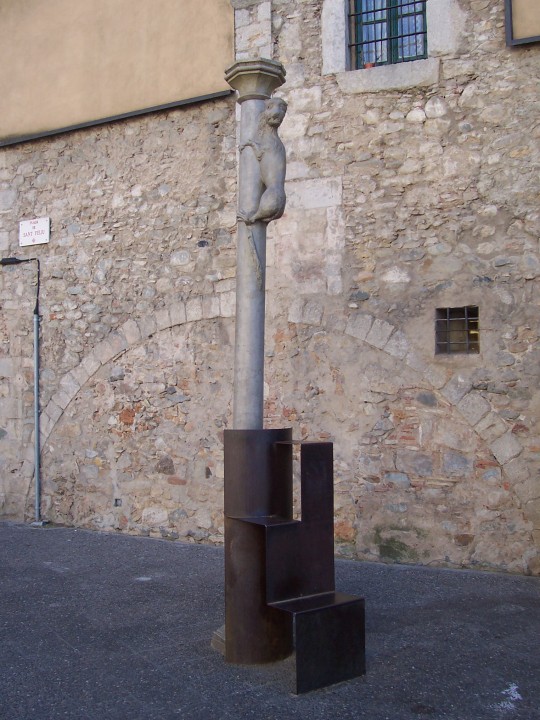
21 notes
·
View notes
Text

Who are we if not the manifestations of our ancestors spells. Their thoughts of a new beginning and better life transform into the future magical beings that we are.
Our ancestors fought long and hard, they felt the pain and hardships that the past brought.
When you truly open yourself up to the guidance of the ancestors and you ask them to make sense of everything that is in front of you, they will.
It has taken me years to figure out my mother's side. I was always told she was cherokee and scotts-irish, and to an extent that is right but that is not including the Iberian/catalonian/basque, french, romani, plus small percentage of african that comes from her side. When I found this out I was so confused and floored especially because as far as I knew, my moms family was not any of those things! But as I did more research and really buried myself into this ancestral work I finally found my answer. This whole time I was looking at everything separately, how is it possible for all these groups of people to have mixed and mingled? I realized that I was looking at this all wrong. I began noticing things about certain groups of people from the area my mom is from. My mom is from Kentucky. Her family has lived all around the Appalachian mountains. Now, her family is in Western Kentucky, close to the Illinois Kentucky line. I happened to fall on a group of people called the Melungeons. Everything about them sounded extremely familiar. From their light eyes, thick dark hair, dark skin, european features, and high cheek bones as well as the familiar last names that I saw on the list of common melungeon surnames like Crow, Allen, Bell, Wise, Moore, Lowry, Greene, Cox, Clark, Collins, Powell, Hopkins, Bridges, Dye, etc.. These names are so important because these are the surnames for my moms family who lived in the areas inhabited by the Melungeons. I feel like my ancestors have been guiding me me to this information for awhile. Learning about our ancestors helps us to learn about ourselves. I will never stop learning of them and their ways. I am going to start a countdown to my new class on working with the Ancestors. Everyday until my new class Working with the Ancestors 101 on Saturday 10/28, I am going to be posting about one of my ancestors every day in their honor. To access my new class check out the link below.
https://courses.zinzeudo.com/courses/Working-With-The-Ancestors-101
#folklore#italian folk magic#italian folk medicine#pyrenees witches#melungeon#romani#french folk magic#ancient history#ancestors#ancestral healing#ancestral veneration#irish witchcraft#irish witch#halloweenmagic#halloween#samhain#streghe#spirits#medium#janara#janare#stregoneria
3 notes
·
View notes
Text
Spain🇪🇸 Here's everything I found, organized by my favorites…

No 1. Netflix movie Akelarre - Coven (2020) Great and beautiful film, loads of history here⭐️⭐️⭐️⭐️⭐️ (see my previous post about the real history behind this film)
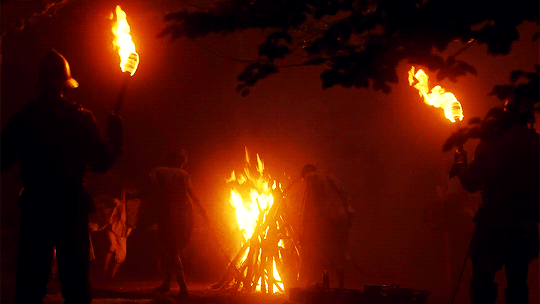
No 2. Witches Mountain🏔El Monte de las Brujas (1972) could be a great movie, but the execution is so poor that it ruins the experience. A photographer takes an assignment in the Pyrenees just across the Spanish border, but soon has supernatural encounters (witches). Waiting for the re-make!

No 3. Witching & Bitching - Las Brujas de Zugarramurdi (2013) has received a controversial reception, I think it was fun and entertaining. The Caves of Zugarramurdi have a historical connection to the Basque witch trials in Navarra. Zugarramurdi is near what is now the French-Spanish border, where there is also a water stream (Olabidea or Infernuko erreka, "Hell's stream") was said to be the meeting place of the witches.

Perhaps here the most interesting seems to be the story of LaCelestina (1499) and I noticed that it was translated into Finnish in 2019 (going to get the book) 📖 The trials of the Basque witches conducted during the 16th and early 17th centuries had a significant effect on the development of Golden Age Spanish Literature.
Often considered the first European novel, La Celestina was profoundly influential in the development of European prose fiction and is valued by critics today as much for its greatness as literature as for its historical significance. No 4. La Celestina (1996) with Penelope Cruz is good - and very romantic- but not a great movie. I haven’t seen the older versions ( poster below).
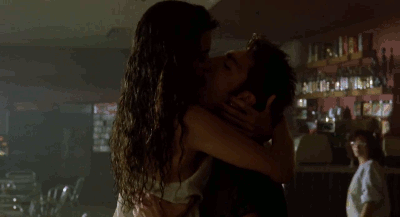
No 5. I tried to watch 1984 film Akelarre- mixed documentary & fiction - but I found only few parts with translation, its content did not seem very science-based, but otherwise interesting.

Few witch trials facts from the area of 🇪🇸 :
TheSpanish inquisition rescued countless of ’witches’ from local legal witch processes (Henningsen 1980; Ankarloo & Clark 2002).
Yes, burning at the stake was used as a method of execution in Spain, unlike in most other countries (Levack 1987).
In Catalonia, the Inquisition was less respected and more people died (Ankarloo & Clark 2002).
The general discourse emphasizes the number of women as victims, but there are large regional differences. In Castile 70 % was women, but in in Aragón 70 % was men. (Schulte 2009)
Navarra is famous for the huge number of defendants, but the number of victims sentenced to death remained low due to the Inquisition.
From Zugarramurdi 6 people were burned alive, 4 women & 2 men, 13 died in prison during The Basque Witch Trials (Henningsen 1980)
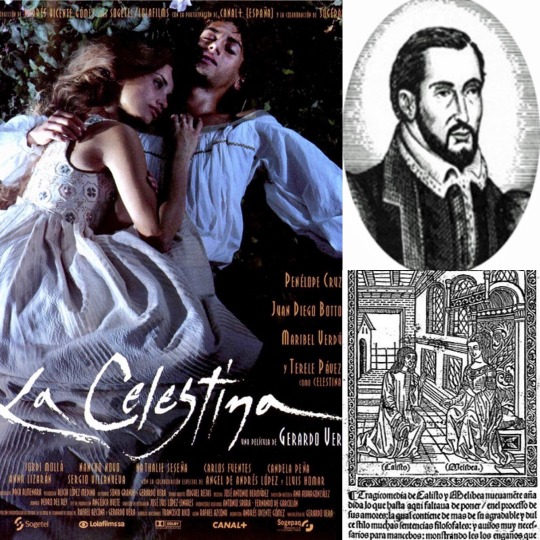
*Places to see in Zugarramurdi: River Infernuko Erreka, Caves, Museum


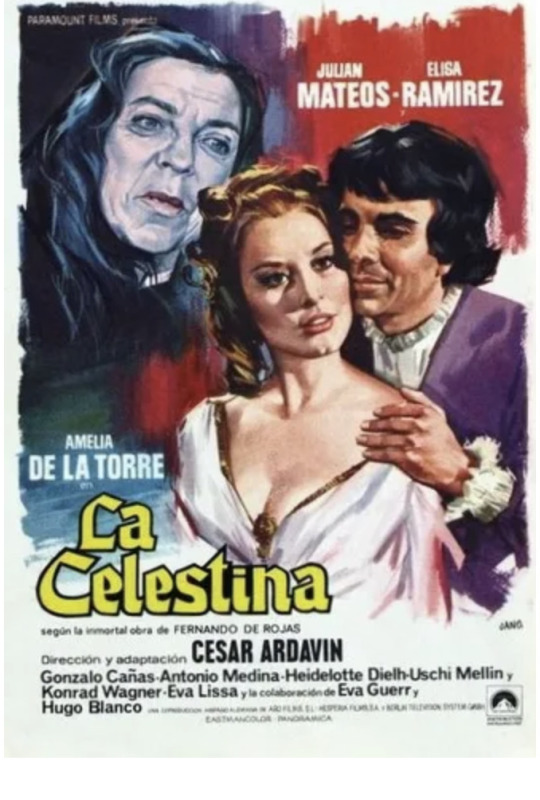
#witchcraft#movies#spain#Navarre#Zugarramurdi#witching & bitching#witches mountain#cinema#folklore#akelarre#netflix#la celestina#penelope cruz#carmen maura#horror film#history#witches#witch#film#horror#basque#catalonia#art history#horror gif#movie gifs
6 notes
·
View notes
Text
WIP progress tag game
RULES: post the names of all the files in your WIP folder regardless of how non-descriptive or ridiculous. Let people send you an ask with the title that most intrigues them and then post a little snippet of it or tell them something about it! And then tag as many people as you have WIPs.
*LAUGHS IN PAIN* Since I have over 300 WIPS across multiple fandoms, I’ll only tag the ones I am like Actively Picking at in some capacity, otherwise we will be here for an eternity and a half! TY @just-another-dreamerr for the tag! FYI this is why I don’t get Shit done half the time…. It’s the ADHD alright! Judgement-free zone! Lmao
RISE TMNT
alleviate the symptoms
APRITELLO WEEK WADDUP
august moonrise
brumation _ apritello qpr
there is light _ bad timeline future!leo
witches hold grudges apparently
03 _ rainy day _ grave visit
04 _ Usagi bonds w Leo’s brothers
05 _ potentially messy
06 _ everything always comes out in the wash
_ baby blue n purple rain shenanigans misc
_ creatures of habit
_ the sharp, sweet taste
_ i go there with you misc
LUCA
_ the Tyrrhenian Sea
_ pyrenees
summer 64 _ colors and constellations
summer 64 _ a sky full of stars
VLD / KLANCE
Keith/Allura/Lance platonic survivor fic
arrows shot into the horizon
DEMON SLAYER
little tempers to quell and small hands to hold
ATLA
moon-touched
platonic fake dating zukka
TAZ BALANCE
every soul accounted for
THE HOBBIT / TOLKIEN
Erebor; the Journey home; and After
more fair than mortal tongue can tell
ONE PIECE
_ post wano lawlu
consequences
i recall a SMILE _ film red
the one where Law is dying and Luffy tries to same him anyway
wild with younger hearts
twists unpleasantly
Usopp values discretion. and his life
ORIGINAL STUFF
an unreachable ocean of light
It takes 67 hours to drive from Tennessee to Alaska. Ask me how I know
if there isn’t a wedding or a funeral then it just isn’t southern
space romance odyssey
what to do with the body _ sci-fi misc
the witch au which is not an au
dragons and lesbians
to maunder
APHELANDRA
shadows taller than our souls
I do Not have the energy to tag this many ppl sorry for being lame but my phone is being a nightmare rn and posting it is all I can do Lmao. I know I got moots that write also so if u see this do it!! MWA!!
#ask game#me ‘ok I’ll only post the ones I’m working on’#me going through my google docs sweating buckets bc damn#I really have opened every single one of these and written some smh#can I focus pls?#can I focus????
1 note
·
View note
Text
Watching Through My Collection: Day 28/36
The Witch's Mountain (1972) aka The Witches Mountain aka El Monte de las Brujas
Day 27 / Day 29
Is operatic singing a talent you can pick up as a witch or is it a prerequisite? 'Cause if I can go off into the Pyrenees Mountains and just sing all the time doing witchcraft, then I will.
This hope is the only thing that got me through this movie.

This movie was incomprehensible. I looked up other reviews to try and piece together what I might've missed and feel like I'm going insane, seeing positive reviews. How anyone kept track of what was going on is beyond me and I apparently did catch every plot important scene.
The movie opens on a woman finding a knife stabbed in a wig and a mess around her house- culminating in the reveal of some creepy little girl that killed the cat and so the lady douses everything in gas and sets the place on fire.
Immediate jump to the same woman getting dumped by her photographer boyfriend, Mario, who we then get to spend the rest of the movie with as he decides a business vacation to the mountains to take pictures is the best thing right after breaking up.
He then creeps on meets another woman who's a freelance writer and he talks her into traveling with him. (Man, were the 70's carefree.)
The only bright moment I had in this movie was when they make it a castle in the mountains and spend the night- the witches have their own Igor-type fella who is so unbothered by everything and everyone.
Then it all devolves into nonsense again. Long, boring scenes of generally uninteresting nature photography, a mystery that has no tension at all, and so much weird stuff going on that I actually managed to get frustrated at the characters for not just deciding to leave.
They even pitched a tent and slept in the witch haunted woods! No wonder they got got!
The freelancer gets driven crazy by the ghost-witches and runs off a cliff and then I'm guessing they all torture Mario? The last scene is essentially him walking in, seeing the witches plus his ex and traveling companion, and the camera panning to some kind of chastity/torture instrument?
I don't think he survived the Witch's Mountain, is all I'm saying.

Also, the witch rituals are always vaguely wedding-esque but idk what they're doing.
#nick is a dangerous man#collection reviews#the witch's mountain#the witches mountain#the witch's mountain 1972#the witches mountain 1972
2 notes
·
View notes
Text
@asongofstarkandtargaryen the interview I told you about. And the release date of the film is on 18th November. Although it will be during the Sitges Film Festival (6th-16th October)
Here's the link to the interview, but it's in spanish so I've translated to make it easier. It's from February, but it has some interesting info.
Paul Urkijo: "Mari is the most powerful character in Basque mythology"
Paul Urkijo is in love with mythology in general and Basque mythology in particular. His films drink from those sources that fill the narratives of ancient legends. The director from Alava has finished 'Irati', his second film after Errementari.
Irati is a fantasy of medieval Euskadi, and Paul Urkijo places the action in the 8th century. The plot revolves around a group of Christian and Muslim warriors who enter the Basque Pyrenees in search of a lost treasure of the Emperor Charlemagne. And it is supposed to be in a cave, according to the locals, guarded by the goddess of the lands, Mari. The group of warriors, led by Eneko, is led by a mysterious young woman from the area named Irati. The film stars Eneko Sagardoy and Edurne Azkarate, and the story begins in a comic by Juan Luis Landa and Joxean Muñoz. Talking with Urkijo means immersing yourself in a world of swords and witches
You studied Fine Arts. Was your idea the audiovisual world?
I originally got into this career to do illustration, and my intention was to go into comics or animation. That was what I thought from my way of making and creating stories. I discovered the audiovisual in Fine Arts. Until then it had never crossed my mind that I could make movies, and even less so here; at least, not the kind of cinema that I liked.
Why did you think you didn't have that chance?
Because the cinema that I like is the fantastic genre. When I was 18, I didn't consider those kinds of possibilities. That yes, the cinema is what I have liked most in life, since I was a child, but at that time what I did the most was draw. In Fine Arts I began to discover the audiovisual world because I had several film subjects, and little by little, making short films, I realized that this was going to be my way of telling stories.
And drawing?
It was also included. In the pre-production of a film there is a lot of drawing, so I was immediately hooked on the audiovisual world. At first I made short films with friends to have fun where we used a lot of ketchup, a lot of tomato.
It seems you like it bloody.
Ha, ha, ha. It has its appeal. Every time I was doing more complex things. Little by little I became a professional, and they were no longer just stories with friends to have fun. I wanted what I was experiencing to be my profession. I took a 3D course, I got an award at EITB Kultura and with 2,000 euros I made a short film, El pez plomo, my first work that can be considered semi-professional.
And Errementari arrived
Well, not so fast. Before I did about fifteen shorts. It was a while before he launched me into making a feature film, and that was big words. It seems that he is a big fan of Barandiaran. Of course, and I can also be very monothematic. I have always been a fan of the fantastic and mythology on an international level. Monsters have fascinated me ever since I was a child. I like the meaning of stories and everything behind them. It is a very nice way to describe ourselves, a way to talk about our darkest things and our brightest moments. I am from where I am and from a very young age I have been deeply touched by Basque mythology. I had stories, I went to the mountains a lot, I visited caves... My aitas (aitas=parents in basque) took me to very interesting places and told me stories.
Stories that you now turn into movies.
Ha, ha, ha. Yes, it can be said that from those stories later came others that have become shorts and movies. At home we had an edition of Barandiaran's Complete Works, and I also bought books, although more modern. Little by little I became interested on a deeper level. I saw in those stories what I needed and wanted to tell.
What did you see in Errementari
A fantastic genre story, fun, but dark and with demons; an imagery that I love, so developing all that, I knew it was perfect. I had a really good time making that movie.
Between Errementari and Irati
Yes. I had always wanted to make a fantastic film, with a historical genre and Basque mythology. I was in love with the idea of doing something sword and sorcery, and this comic had enough ingredients to make the movie that I wanted. He had certain nuances that made me go headlong toward him. It drinks directly from Basque mythology and has the perfect excuse to be able to combine history and mythology. I was inspired by the main characters, but I went to the origin.
Did it go off script?
In a way. Yes, I passed a little on the aesthetics, the tone, even the narration of the comic, and in the end I have done something totally different. People who expect something similar to comics will not find it in Irati. It is a much more adult narration, which delves much more into what for me is Basque mythology. It gets a lot into the symbology of those telluric characters related to nature and the beliefs that pagan people had, as opposed to other religions that came later.
It has dropped a lot, from the 21st to the 8th century.
I am not a historian; I am a fan of history and my profession is to tell stories, especially fantasy genres. I use historical settings and periods to immerse the viewer in the lives of my characters, and the 8th century is a fascinating time.
Although seen from a distance of thirteen centuries apart, it seems like a very dark time.
There is no documentation at all. There are very few engravings, there are very few codices, there are very few writings, but in every dark age there have been lights. Christianity has not established the iconography that we are going to see later in the churches. We meet pagan deities who are later transformed into Christian deities. It is a game that is very present in the stories of Barandiaran, where there is always a game between the Christian and the pagan.
Irati is one of the main characters, but many will think that the title refers to the Irati jungle, in Navarra.
I play with that idea. The protagonist is Eneko, a young Christian and nobleman who aims to be the leader of the area, while she is a pagan girl. In order to complete his mission and be the Jaun (lord in basque), Eneko will need the help of Irati. With it you will immerse yourself in that inhospitable, magical and dark jungle that we call Irati.
You have fulfilled your fantastic goals with two films like Errementari and Irati
Ha ha ha. I would love to, because those movies are much easier to produce. I have current stories and projects planned for the future, but right now, what comes to mind is from the period and in complicated locations, with swords, with monsters. After this film, which has been a great epic at the production level, I would like to do something simpler, to rest.
What is the Basque territory that treasures the most mythology?
It is difficult to choose and they all share mythology.
You have chosen Mari.
And Mari is in all herrialdes. Language unites us. Mythology comes to us through oral transmission, and in Basque. There are many studies linking Mari to a matriarchal goddess who was part of a religion that was all over Europe.
What is your favorite character within the mythology of Euskal Herria?
Mari, so we go back to her. It has a power so deep that it is part of all of us. It represents Amalurra, the mother of all creatures. It is fair and terrible in equal parts. Mari is the most suggestive and powerful character in Basque mythology. It is exciting in all the forms it can take: fire, storm, gold, skeleton, snake and all possible animals. It is a unique character that is within my dreams.
And your dreams are about monsters, witches, storms, darkness. A nightmare?
Ha ha ha. No. When I think of monsters, I dream of empathizing with them. They are not a nightmare. I like them because I try to see the other side, because I see the incomprehension that exists in this world towards creatures that are different.
How long has the filming of your film lasted? Eight weeks
Is it a lot or a little?
For what is usually done in independent cinema, it is a lot. We have had the help of the Basque Government, EITB, TVE, the Gasteiz city council. Many people have helped us. Thanks to all of them we have been able to produce a fantastic genre film in Basque. This has been a very complicated project, but I am very stubborn. It's been four or five years of development. Today, making an eight-week film is very complicated. Normal is between four and five.
What route do you think Irati is going to have?
We're in post-production and thinking about the fall festivals. We want to treat the film in the most traditional way possible.
Cinemas?
Exactly, and then it will go to platforms, that's the world we're in. We want it to go to cinemas, festivals and everywhere possible. It is a film that I have tried to make as big as possible. I have wanted to make an epic film so that it can be seen on a cinema screen.
Can you tell who finds Charlemagne's treasure?
No. For that you will have to wait and see the movie, and that is if Charlemagne's treasure exists.
What does a filmmaker like you live on when the cameras are turned off and the story is already finished?
There were times when I had to work doing everything. I've been a waiter, I've been on assembly lines, as a drawing teacher. Of everything. When you go to feature film and make a movie you try to save up to last the time it takes to get to the next one.
In this case, five years, how much does it stretch the money?
Ha ha ha. That valley is usually usually tricky. Let's say that the illusion is what pushes you and you have to cling to it a lot so as not to get sidetracked thinking that you have to pay the flat.
Is Basque cinema in fashion?
I think we're doing pretty well. There have always been great Basque films, but perhaps since Aupa Etxebeste! our cinema has taken off. From a certain point, films have begun to be made in Basque that are consumed nationally and internationally.
Handia was about to go to the Oscars.
The Moriarty production company is the spearhead of Basque cinema. What others do affects us, just as what I do affects others. I think that in Basque cinema we feed off each other, and all at the same time we are creating an increasingly professional, increasingly stable industrial fabric, and that is why we have more and more work in the Basque Country. For example, it is very difficult to find technicians for a film. When we went to do Irati we had a hard time, because they were in other series and other movies. We have a good outlook.
Would you like to make non-independent cinema?
Yeah, of course. Maybe you don't have as much creative freedom, but at an industrial level you can make very big, contrived and fun movies, it wouldn't be bad at all. It is also true that I make films because I like to tell my own stories.
Do you think that in the end we will end up seeing all the movies on platforms?
I think and hope not. People, with this pandemic, have stayed at home and have gotten used to watching movies there, but I think the time will come, if it hasn't already, when people once again have the need to share the films in larger spaces, where the experience is different. I am hopeful that theaters will be strong again.
And with popcorn included, right?
That of course. A good movie and a good carton of popcorn. We will return to it and we will see the cinema as we have always seen it, in theaters. It is true that I have also gone less because of the situation we have been through, but I have tried to go to a room every week.
In your first film you used three dialects of Basque. In this one?
A dialect of Basque, Latin and Arabic. These last two languages are brushstrokes that we have put. Basque is Navarrese with a very old nuance, but totally understandable. All this will help us immerse ourselves in that time, the 8th century.
Does your movie has age restrictions?
No, my film is immortal. Seriously, it's an adult movie, I haven't limited anything, but totally understandable. All this will help us immerse ourselves in that time, the 8th century. Is your movie old? No, my film is immortal. Seriously, it's an adult movie, I haven't limited anything, but I think it's a movie that everyone could see. It is an adventure story, entertaining, with its dark moments, with violence. I'm not going to be the one to categorize it. Hopefully the younger ones will see it too.
**********
About the director...
Age: 37 years old (June 22, 1984).
Place of birth: Gasteiz.
Education: Bachelor of Fine Arts.
Career: Once he discovered the audiovisual universe in college, he launched himself into the world of short films. His works in this field have won 85 national and international awards and have been selected for festivals some 400 times. In 2016 he wrote the bible for his first feature film, based on the Basque story Patxi Errementaria. With this film he has won numerous awards, including the award for best film at the Terror Week in San Sebastian. Five years later, he has returned to command to make his second feature, Irati, an epic story that will travel through the autumn festivals.
3 notes
·
View notes
Text
Beyond the Living Dead


It opens with a funeral cut short by a thunderstorm, despite the fact those present are interring the body in a mausoleum. I’d like to say that’s the weirdest thing about Jose Luis Merino’s BEYOND THE LIVING DEAD (1973, Tubi) — aka ORGY OF THE DEAD, aka THE HANGING WOMAN, aka RETURN OF THE ZOMBIES, aka BRACULA: TERROR OF THE LIVING DEAD — but I’d be lying. Count Minajli has died, leaving his estate to his daughter, who turns up dead before the reading of the will. Instead, it goes to his nephew (Stelvio Rosi), much to the consternation of his widow (Maria Pia Conte) and the scientist (Gerard Tichy) whose research into life energy he’s been sponsoring. Conte is a witch, but that goes nowhere. She’s having sex with a necrophiliac grave digger (Paul Naschy), as whom wouldn’t, who feels he’s cheating on the corpses he’s been hiding in a secret passageway between the castle and the mausoleum. And that goes nowhere. After finding out Conte has seduced Rosi (in a scene with a relentlessly revolving overhead shot of their naked bodies), the scientist’s daughter (Dyanik Zurakowska) offers herself to him, so he makes her strip then tells her she’s stupid. Naturally they fall in love. As the bodies pile up, suspicion falls on Rosi for no discernible reason, so he starts trying to solve the crimes himself. It’s like the Hardy Boys with bare breasts and zombies. After an impressive musical cue with choral voices for the funeral, Francesco De Masi’s score sounds an awful lot like the music for DARK SHADOWS, and then ends with a variation on “Tara’s Theme” from GONE WITH THE WIND. Adding to the delirium is the dubbing, with British accents that sound as if they were being done by American actors. The dubbing is also extremely energetic. I suspect the voice actors were better actors than the originals. It’s all so loopy it’s almost exhilarating. If it seemed deliberate and had a little more panache, we’d be hailing Merino as a stylist on a par with Douglas Sirk and John Waters. The only thing of any real artistic merit is the Eastmancolor location photography of the Pyrenees, but for all that, I defy you to take your eyes off the screen.
0 notes
Text



A beautiful interview in The Guardian/Observer this weekend with the almighty Kate Dickie by Mark Kermode.
Some very nice words about Couple in a Hole...
"But it’s Couple in a Hole (2015) that most viscerally showcases Dickie’s ability to get inside a character. The film is a raw, emotional drama about a Scottish couple literally holed up in a cave-like dwelling in the Pyrenees after losing a child. “That was one of the saddest, purest characters I’ve played,” says Dickie. “Her grief was just so focused on her son that anything outside of that hole felt like a betrayal, to the point of shoving her husband away. She was one of the characters that I struggled the most to let go and grieve. I did that film back-to-back with The Witch – and by the end of it I was in a dark place.”"
The full article here: https://www.theguardian.com/.../kate-dickie-actor...
If you happen to be in Shetland next weekend, you can see it there at Shetland Arts festival on Saturday 3 September at 2.30pm followed by Q&A with Kate Dickie herself!
https://tickets.shetlandarts.org/.../sp22-couple-in-a...
Or you can still watch the film for free on Amazon Prime
https://www.amazon.co.uk/.../B01DTJ.../ref=atv_dp_share_cu_r
Pls leave a review once you watched it as it really helps the film.
Paul HigginsJérôme KircherCorinne Masiero OfficielleZorana PiggottSam CareBeak> Geoff Barrow Barrow Billy FullerPierre VinourDries PhlypoAurélie BordierBFI
More info here
1 note
·
View note